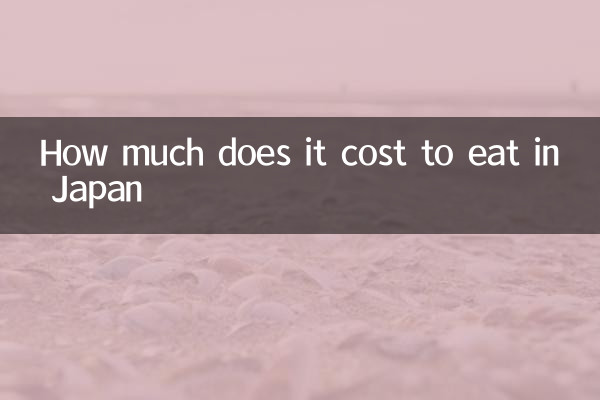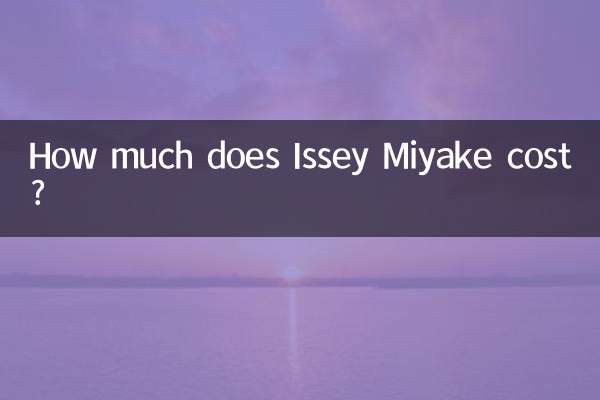How much does it cost to eat in Japan? The latest catering consumption guide in 2024
Recently, Japan's tourism popularity has continued to rise, and one of the questions that many tourists are most concerned about is "How much does it cost to eat in Japan?". This article will provide you with a detailed analysis of the current status of Japanese catering consumption based on hot topics and the latest data on the Internet in the past 10 days, and attach a structured data comparison.
1. Overview of Japan’s catering consumption level

According to the latest statistics from the Japan Tourism Agency and feedback from tourists, Japan’s catering consumption shows obvious regional and category differences. Prices in big cities such as Tokyo and Osaka are relatively high, while local cities are relatively affordable.
| Catering type | Tokyo price range (yen) | Osaka price range (yen) | Local city price range (yen) |
|---|---|---|---|
| Hand-Pulled Noodle | 800-1,500 | 700-1,300 | 600-1,000 |
| Gyudon | 400-800 | 350-700 | 300-600 |
| Sushi (conveyor belt) | 100-500/plate | 90-450/plate | 80-400/plate |
| Izakaya | 3,000-8,000/person | 2,500-6,000/person | 2,000-5,000/person |
| Convenience store bento | 400-800 | 350-700 | 300-600 |
2. The latest price change trend in 2024
Affected by the depreciation of the yen and inflation, Japanese restaurant prices will generally increase by 5-15% in 2024. In particular, the following categories have experienced significant increases:
1.Beef dishes: Affected by the rise in imported beef prices, the price of Wagyu cuisine increased by about 12% year-on-year.
2.Seafood: Affected by the nuclear wastewater incident, the prices of some seafood fluctuated greatly, with an increase of about 8-20%.
3.fast food chain: Yoshinoya, Matsuya and other major chain stores have raised prices by 5-10%
The following are specific price examples of recent popular restaurants:
| Restaurant name | Recommended dishes | Price(yen) | waiting time |
|---|---|---|---|
| Ichiran Ramen(Shinjuku store) | Signature Ramen | 1,390 | 30-60 minutes |
| Crab Doraku (Dotonbori main store) | Lunch set | Starting from 4,500 | Reservation required |
| Hidden Sushi (Akihabara store) | Conveyor belt sushi | 146/plate | 20-40 minutes |
| Rikyu Beef Tongue (Sendai Station Store) | Beef tongue set meal | 2,200 | 15-30 minutes |
3. Tips for saving money on dining
1.Take advantage of the lunch set: Lunch prices at many high-end restaurants are 30-50% cheaper than dinner prices
2.Pay attention to chain store offers: Download apps such as Matsuya and Shiqijia to get coupons often
3.Convenience store selection: 7-11 and Lawson’s bento boxes are very cost-effective, and you can get a meal for about 500 yen.
4.Supermarket evening discount: There are usually 30-50% discounts in the supermarket deli area after 19:00
4. Price comparison of specialty restaurants in various regions
| area | Specialties | Average price (yen) | Recommended stores |
|---|---|---|---|
| Tokyo | Tsukiji Market Seafood Donburi | 2,500-4,000 | Yamato Sushi |
| Osaka | Takoyaki | 500-800/6pcs | red ghost |
| Kyoto | kaiseki | 8,000-30,000 | Hyoting |
| Hokkaido | Seafood Market Don | 1,800-3,500 | Sapporo OTC Market |
| Fukuoka | Hakata Ramen | 700-1,200 | Ippudo main store |
5. Summary and suggestions
Japanese dining expenses range from 300 yen for a convenience store rice ball to 30,000 yen for a high-end kaiseki meal. Visitors can choose flexibly according to their budget. It is recommended to make the following preparations in advance:
1. Download food review APP (Tabelog, Google Maps) to check real-time prices
2. Prepare cash, some old stores only accept cash.
3. Make reservations at popular restaurants 1-2 weeks in advance
4. Avoiding meal times (12:00-13:00, 18:00-20:00) in tourist areas can reduce waiting
Properly plan your dining budget so that you can experience Japanese food culture without causing a financial burden. Hopefully this latest guide will help you plan the perfect food trip to Japan!

check the details

check the details